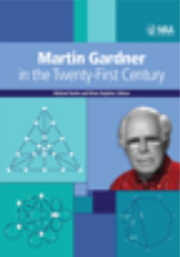Book contents
- Frontmatter
- Preface
- Contents
- I Geometry
- II Number Theory and Graph Theory
- III Flexagons and Catalan Numbers
- IV Making Things Fit
- 17 L-Tromino Tiling of Mutilated Chessboards
- 18 Polyomino Dissections
- 19 Squaring the Plane
- 20 Magic Knight's Tours
- 21 Some New Results on Magic Hexagrams
- 22 Finding All Solutions to the Magic Hexagram
- 23 Triangular Numbers, Gaussian Integers, and KenKen
- V Further Puzzles and Games
- VI Cards and Probability
- VII Other Aspects of Martin Gardner
- Index
- About the Editors
23 - Triangular Numbers, Gaussian Integers, and KenKen
from IV - Making Things Fit
- Frontmatter
- Preface
- Contents
- I Geometry
- II Number Theory and Graph Theory
- III Flexagons and Catalan Numbers
- IV Making Things Fit
- 17 L-Tromino Tiling of Mutilated Chessboards
- 18 Polyomino Dissections
- 19 Squaring the Plane
- 20 Magic Knight's Tours
- 21 Some New Results on Magic Hexagrams
- 22 Finding All Solutions to the Magic Hexagram
- 23 Triangular Numbers, Gaussian Integers, and KenKen
- V Further Puzzles and Games
- VI Cards and Probability
- VII Other Aspects of Martin Gardner
- Index
- About the Editors
Summary
One of the first of Martin Gardner's Mathematical Games columns I ever read was “Euler's Spoilers,” in November 1959 [1], and after all these years I think it is still my favorite (maybe this is just because I love the way he rhymed ‘Euler’ and ‘spoiler’). It dealt with what we now call Latin squares, n × n arrays using n symbols such that each symbol appears exactly once in each row and column.
Latin squares are extremely useful in the design of statistical experiments, but they are perhaps better known now for their appearance in recreational puzzles such as sudoku where each row and each column of a 9 × 9 array contains each of the integers 1, 2, …, 9 exactly once. In 2004, a Japanese mathematics teacher, Tetsuya Miyamoto, invented a sudoku-like puzzle called KenKen (loosely translated, this means “wisdom squared”). KenKen quickly became so popular that it is now a standard feature in newspapers around the world, and there are two very good web sites ([2], [3]) that offer new puzzles daily online.
As in sudoku, the goal in KenKen is to fill an n × n grid with the numbers 1 through n so as not to repeat a number in any row or column. Despite the fact that it uses numbers, sudoku is not an arithmetical puzzle; any nine symbols could be used in place of the integers 1-9. Solving a KenKen puzzle, on the other hand, depends heavily upon several important ideas about numbers.
- Type
- Chapter
- Information
- Martin Gardner in the Twenty-First Century , pp. 173 - 178Publisher: Mathematical Association of AmericaPrint publication year: 2012



